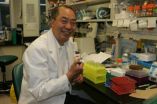(Press-News.org) CAMBRIDGE, Mass. (July 17, 2014) – From fertilized egg to adult, the cells of the human body go through an astronomical number of divisions. During division of any of the body's roughly 30 trillion cells, DNA from the initial cell must be split precisely between the two resulting cells. Critical to successful cell division is the integrity of the centromere—a region of DNA on each chromosome where the cell division machinery attaches to segregate the chromosomes. For the segregation machinery to recognize this region, it must contain many copies of a pivotal protein known as CENP-A.
Each time the cell makes a copy of its DNA in preparation for cell division, it needs to ensure that the centromeres of the new and old DNA strand get re-filled with CENP-A. Although scientists have known that the centromere replenishes its stock of CENP-A deposits during a phase of the cell cycle referred to as G1, exactly how this process is regulated had remained a mystery.
Now work by Whitehead Institute Member Iain Cheeseman and Kara McKinley, a graduate student in Cheeseman's lab has identified the molecular controls that ensure that CENP-A deposition at centromeres occurs in the right place at precisely the right time. Their findings are described in the current issue of the journal Cell.
In preparation for mitosis, the cell's DNA is copied and condensed into paired chromosomes. Thin protein fibers, called microtubules stretch out from points on opposite sides of the cell and latch onto a protein complex, called the kinetochore, which is anchored by CENP-A molecules at the centromere. As mitosis progresses, the microtubules align the chromosomes along the mid-line of the cell, then shorten and pull the chromosome pairs at their centromeres to opposite sides of the cell.
The fate of the cell depends on this process going smoothly. If the chromosomes have too many or too few centromeres, or the centromeres are located in the wrong place, proper chromosome segregation fails, and the cell either dies or becomes diseased. Because the centromere's integrity is so vital, its precise location is amazingly maintained each time cells divide, and passed on through multiple generations.
In her research, McKinley found that two kinases—Plk1 and CDK—work in separate steps to ensure that CENP-A replenishment proceeds correctly. For CENP-A to fill in all of the gaps in the centromere, both steps must work correctly. By defining the ways in which these kinases work, McKinley was able to disrupt the precise timing of CENP-A replenishment and cause severe problems for chromosome segregation.
"The assumption was that the timing of CENP-A replenishment had to be important for centromere function because it was so tightly controlled. Now we have finally been able to test that assumption," says McKinley.
"Kara's work has defined the basis for how the CENP-A deposition process is controlled," says Cheeseman, who is also associate professor of biology at Massachusetts Institute of Technology. "Since this step is such a central part of being a centromere, her work is a fundamental advance in how we think about this as a process."
INFORMATION:
This work is supported by the Leukemia and Lymphoma Society, the National Institutes of Health (NIH; GM088313), and the American Cancer Society.
Written by Nicole Giese Rura
Iain Cheeseman's primary affiliation is with Whitehead Institute for Biomedical Research, where his laboratory is located and all his research is conducted. He is also an associate professor of biology at Massachusetts Institute of Technology.
Full Citation:
"Polo-like kinase 1 licenses CENP-A deposition at centromeres"
Cell, July 17, 2014.
Kara L. McKinley (1) and Iain M. Cheeseman (1)
1. Whitehead Institute and Department of Biology, MIT Nine Cambridge Center, Cambridge, MA 02142, USA
Faithful cell division requires tightly controlled protein placement at the centromeres
2014-07-17
ELSE PRESS RELEASES FROM THIS DATE:
One third of cancer patients are killed by a 'fat-burning' process termed 'cachexia'
2014-07-17
VIDEO:
One third of cancer patients are killed by a 'fat-burning' process known as cachexia.
Click here for more information.
Most cancer researchers are working on the biology of the tumour. However, Michele Petruzzelli, a member of Erwin Wagner's group at the Spanish National Cancer Research Centre (CNIO), has been looking for ways to attack the disease indirectly. He focused on the effects of tumours on the rest of the body, and not on the tumour itself. His work on the body's ...
Researchers discover new link between obesity, inflammation, and insulin resistance
2014-07-17
La Jolla, Calif., July 17, 2014 - A new study by researchers at Sanford-Burnham Medical Research Institute (Sanford-Burnham) has identified a new signal that triggers the events leading to insulin resistance in obesity. The signal causes inflammation in adipose tissue and leads to metabolic disease. The study, published July 17 in Cell Metabolism, suggests that blocking this signal may protect against the development of metabolic disease, type 2 diabetes, and other disorders caused by obesity-linked inflammation.
"We have uncovered a precise mechanism that explains how ...
New gene discovered that stops the spread of deadly cancer
2014-07-17
VIDEO:
Salk scientists have discovered the gene responsible for the aggressive spread of a common lung cancer.
Click here for more information.
LA JOLLA—Scientists at the Salk Institute have identified a gene responsible for stopping the movement of cancer from the lungs to other parts of the body, indicating a new way to fight one of the world's deadliest cancers.
By identifying the cause of this metastasis—which often happens quickly in lung cancer and results in a bleak ...
International research team discovers genetic dysfunction connected to hydrocephalus
2014-07-17
The mysterious condition once known as "water on the brain" became just a bit less murky this week thanks to a global research group led in part by a Case Western Reserve researcher. Professor Anthony Wynshaw-Boris, MD, PhD, is the co-principal investigator on a study that illustrates how the domino effect of one genetic error can contribute to excessive cerebrospinal fluid surrounding the brains of mice — a disorder known as hydrocephalus. The findings appear online July 17 in the journal Neuron.
Cerebrospinal fluid provides a cushion between the organ and the skull, ...
A region and pathway found crucial for facial development in vertebrate embryos
2014-07-17
CAMBRIDGE, Mass. (July 17, 2014) – A signaling pathway once thought to have little if any role during embryogenesis is a key player in the formation of the front-most portion of developing vertebrate embryos. Moreover, signals emanating from this region—referred to as the "extreme anterior domain" (EAD)—orchestrate the complex choreography that gives rise to proper facial structure.
The surprising findings, reported by Whitehead Institute scientists this week in the journal Cell Reports, shed new light on a key process of vertebrate embryonic development.
"The results ...
Tak Mak study in Cancer Cell maps decade of discovery to potential anticancer agent
2014-07-17
(TORONTO, Canada – July 17, 2014) – The journal Cancer Cell today published research led by Dr. Tak Mak mapping the path of discovery to developing a potential anticancer agent.
"What began with the question 'what makes a particular aggressive form of breast cancer cells keep growing?' turned into 10 years of systematic research to identify the enzyme PLK4 as a promising therapeutic target and develop a small molecule inhibitor to block it," says Dr. Mak, Director of The Campbell Family Institute for Breast Cancer Research at the Princess Margaret Cancer Centre, University ...
Gender quotas work in 'tight' cultures, says new paper from the University of Toronto
2014-07-17
Toronto – Quotas probably won't get more women into the boardroom in places like the U.S. and Canada.
They have a better chance however in countries such as China or Germany where people place a higher value on obeying authority and conforming to cultural norms, say a pair of researchers at the University of Toronto's Rotman School of Management. Their conclusions are published in the journal Organizational Dynamics and in a blog for the Harvard Business Review.
It all comes down to a culture's "tightness" or "looseness" -- the degree to which a culture maintains social ...
A new view of the world
2014-07-17
New research out of Queen's University has shed light on how exercise and relaxation activities like yoga can positively impact people with social anxiety disorders.
Adam Heenan, a Ph.D. candidate in the Clinical Psychology, has found that exercise and relaxation activities literally change the way people perceive the world, altering their perception so that they view the environment in a less threatening, less negative way. For people with mood and anxiety disorders, this is an important breakthrough.
For his research, Mr. Heenan used point-light displays, a depiction ...
Transplant patients who receive livers from living donors more likely to survive
2014-07-17
(PHILADELPHIA) – Research derived from early national experience of liver transplantation has shown that deceased donor liver transplants offered recipients better survival rates than living donor liver transplants, making them the preferred method of transplantation for most physicians. Now, the first data-driven study in over a decade disputes this notion. Penn Medicine researchers found that living donor transplant outcomes are superior to those found with deceased donors with appropriate donor selection and when surgeries are performed at an experienced center. The ...
GW researcher unlocks next step in creating HIV-1 immunotherapy using fossil virus
2014-07-17
WASHINGTON (July 17, 2014) — The road to finding a cure for HIV-1 is not without obstacles. However, thanks to cutting-edge research by Douglas Nixon, M.D., Ph.D., and colleagues, performed at the George Washington University (GW), Oregon Health & Science University, the University of Rochester, and UC San Francisco, the scientific community is one step closer to finding a viable immunotherapy option for HIV-1, using an immune attack against a fossil virus buried in the genome.
A major hurdle in eradicating HIV-1 has been outsmarting the frequent mutations, or changing ...





